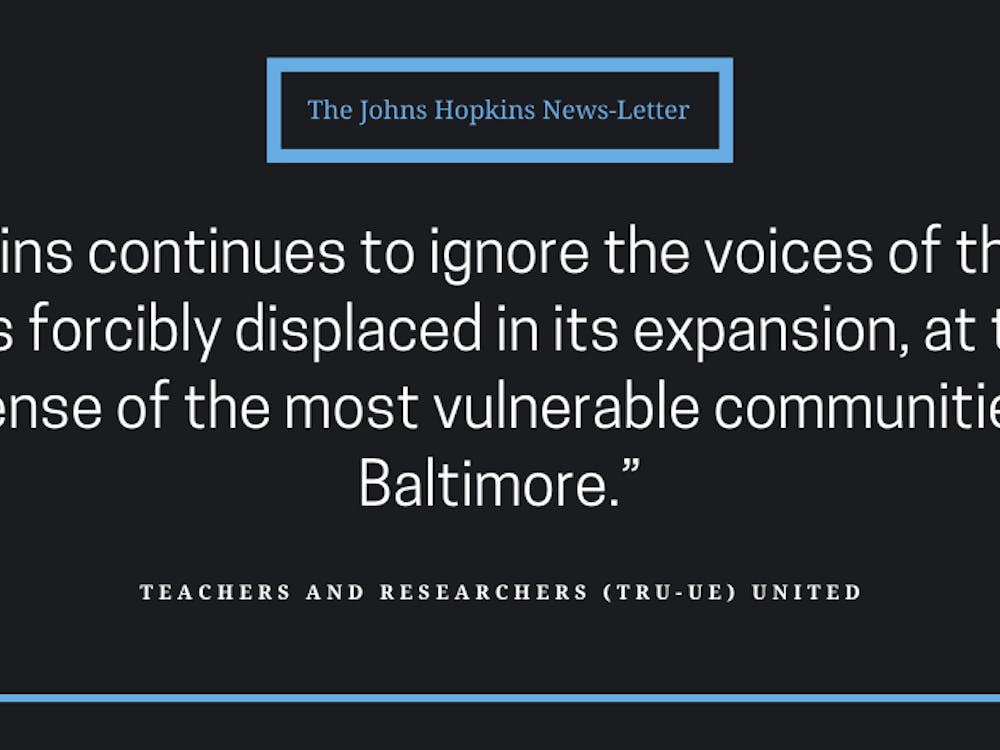Despite participating universities anticipating some major challenges, the Maryland Collaborative to Reduce College Drinking and Related Problems is rolling out and here to stay.
As the name suggests, the Maryland Collaborative is a joint effort by a number of Maryland’s higher education institutions to curtail college drinking and its resulting problems on the state level.
The collaborative is a fairly new entity, having established its governing council as recently as February of 2013. However, David Jernigan, an associate professor at the Johns Hopkins Bloomberg School of Public Health (JHSPH) and the director of its Center for Alcohol Marketing and Youth (CAMY), explained that the roots of the collaborative go back much farther.
“The concept was nurtured in meetings between [Maryland] Secretary of Health and Mental Hygiene Dr. Joshua Sharfstein, Chancellor Britt Kirwan of the University System of Maryland (UMD)and [Hopkins] President [Ronald J.] Daniels in the summer and fall of 2011,” Jernigan wrote in an e-mail to The News-Letter.
Preliminary meetings between the founding groups matured into a number of research projects aimed at establishing the base of a collaborative effort in relation to the topic.
“My team at Hopkins and another team of public health experts at University of Maryland at College Park, headed by Dr. Amelia Arria, began working to assess colleges, create a compendium of best practices and build towards a collaborative in July of 2012,” Jernigan wrote.
These assessments of Maryland’s universities brought key issues surrounding college drinking to light.
“About a third of our college students reported driving under the influence of alcohol or other drugs,” Jernigan wrote. “The highest-risk drinkers tend to drink more heavily and are less likely to use and access services than is true nationwide.”
Jernigan went on to highlight statistical evidence that asserts an underage drinking problem on college campuses. He explained that 19 percent of underage drinkers and 22 percent of students between the ages of 21 and 24 meet the criteria to be classified as practicing alcohol abuse or dependence.
“There’s nowhere near that number of students getting help,” Jernigan wrote. “It’s a myth that that the college drinking problem is inexperienced drinkers who are free to drink for the first time. A substantial chunk of the college drinking problem is kids who had drinking problems in high school.”
The compendium of best practices produced by the collaborative expresses that resolving college drinking problems cannot take place solely on the individual level.
“A lot of the most effective things we can do about alcohol is by changing the environment in which people make their choices about drinking,” Jernigan wrote.
Hope McPhatter, the assistant director for health promotion at the University of Maryland Health Center, praised the compendium of best practices that the collaborative generated.
“This is an excellent compendium of known strategies and evidence of effectiveness interventions,” McPhatter wrote in an e-mail to The News-Letter. “We are better informed practitioners as a result.”
However, only some of Maryland’s colleges formed the first wave of institutions participating in the collaborative. Flavius Lilly, the assistant vice president for Academic and Student Affairs at the University of Maryland, Baltimore, explained why his specific campus had not yet signed onto the collaborative, which other members of the University of Maryland system have joined.
“The University of Maryland, Baltimore student body is predominantly graduate (PhD, MS) and professional (MD, JD, DDS, MSW, PharmD) students. The Maryland Collaborative has focused their attention thus far on undergraduates,” Lilly said.
The types of strategies emphasised by the collaborative have guided participating university officials across Maryland in formulating new measures to tackle the problems related to college drinking, as well as emphasising existing initiatives.
Rachel Drennen, coordinator of Greek Life and Orientation at Hopkins, discussed some of the measures that the University is advancing in response to the collaborative.
“The Center for Health Education and Wellness [CHEW]. . .does a lot of education that’s peer-to-peer about the physical effects and mental effects are of alcohol consumption,” Drennen said.
However, Barbara Schubert, the associate director of CHEW, stressed that education programs are not intended to lecture students about the evils of drinking.
“Our approach is more of a risk-reduction,” Schubert said. “We come at it from a place where students are going to drink and if they’re drinking underage, to please be aware of the risks involved.”
In addition to the peer-to-peer programs being implemented by CHEW, a variety of other measures are currently underway.
“We will be rolling out a new risk-prevention campaign for fraternities and sororities beginning this spring,” Drennen said. “It’s a classroom-based format that puts students in small groups and works them through our curriculum.”
Drennan also pointed out larger community-based initiatives that are being undertaken in concert with the collaborative’s goals.
“At the broader, state level, especially within the Charles Village community, there is a group of people working with vendors...who sell alcohol about what compliance looks like in terms of ID-ing,” Drennan explained.
Both Drennen and Schubert expressed some optimism about existing efforts and those guided by the collaborative.
“It’s been fairly impactful,” Drennen said. “Certainly students know, based on orientation and the year-long programming that happens, what happens to you when you drink alcohol and where you don’t want to be in terms of your consumption.”
“I think in terms of raising awareness we’ve done very well in that area,” Schubert concurred.
Schubert highlighted an advertizing campaign advocating that students stop drinking when they feel ‘buzzed.’
“The Stop@Buzzed message was focus-tested with students, and that’s the one the resonated the most with them,” she said.
Yet both Drennen and Schubert admitted that gauging the success of the University’s efforts, as well as those undertaken by the collaborative as a whole, is not always straightforward.
“This is really a baseline year, so we’re really looking at seeing what the issues are and setting up our strategies,” Schubert said. “We won’t really be able to see anything until probably next year at the very least.”
Drennan stressed that the programs success is reliant upon student participation.
“Is it effective? Honestly, I’m not sure, and I think it takes student buy-in and student promotion of the concept in order for actual change to happen. It can’t come from the top down,” she said.
Drennen yielded that the student promotion, which is seen as vital to reducing college drinking problems, is not always forthcoming. When asked about whether or not students, particularly those involved in Greek Life, showed commitment to addressing these problems, her answer underscored mixed reactions.
“To be perfectly honest, sometimes yes, sometimes no. I think we have a long way to go,” she said.
Moreover, the approaches stressed by the collaborative may encounter serious obstacles in the form of environmental factors that promote drinking, Drennan and Schubert explained.
“Culturally at Hopkins, we have a challenging environment for students who don’t wish to consume alcohol. It’s really present here,” Drennen said.
“Working with local vendors. . .there may be some resistance there,” Schubert added. “We’ve had obstacles in dealing with our Baltimore City liquor control board. They’re not as active in this movement as they might be in other counties.”
Schubert also discussed the commercial factors that impede the collaborative’s efforts.
“The industry itself, which is beyond Maryland, comes up with newer products and tries to target younger people,” she said. “It’s interesting. . .how similar is it to the tobacco industry, but yet we have not really targeted the alcohol industry in the way that we have with tobacco because of the now obvious effects of second-hand smoke.”
In spite of these serious challenges, participating university officials remain committed to the collaborative and optimistic about its prospects.
“It’s actually really interesting. It’s the first of its kind to use public health strategies to engage students and community members,” Drennen said. “I think it’s incredibly effective.”
“I think that the collaborative will help boost looking at the issue on a bigger scale in terms of environmental factors. I think that’s a really important piece that we haven’t really addressed,” Schubert said.
There is also widespread acceptance among university officials of the legal framework in which the collaborative seeks to act; there is no apparent desire from participants to see the legal drinking age changed in Maryland.
The enforcement of the laws, rather than the laws themselves, is seen as the main issue facing state authorities.
“There is a very large and solid body of research that has demonstrated that 21, even poorly enforced, saves lives,” Jernigan wrote.
“Maintaining the drinking age is important,” Drennen stressed.
“I think we could do better probably in our enforcement issue,” Schubert added.
The complexity of the problems which arise from college drinking is frequently raised by participants as one of the main challenges the collaborative currently faces.
“There is no single bullet that’s going to take care of this problem,” Jernigan said.
However, the energy and commitment of those involved in the Maryland Collaborative suggest that they are more than prepared to take a shot at it.






















Please note All comments are eligible for publication in The News-Letter.